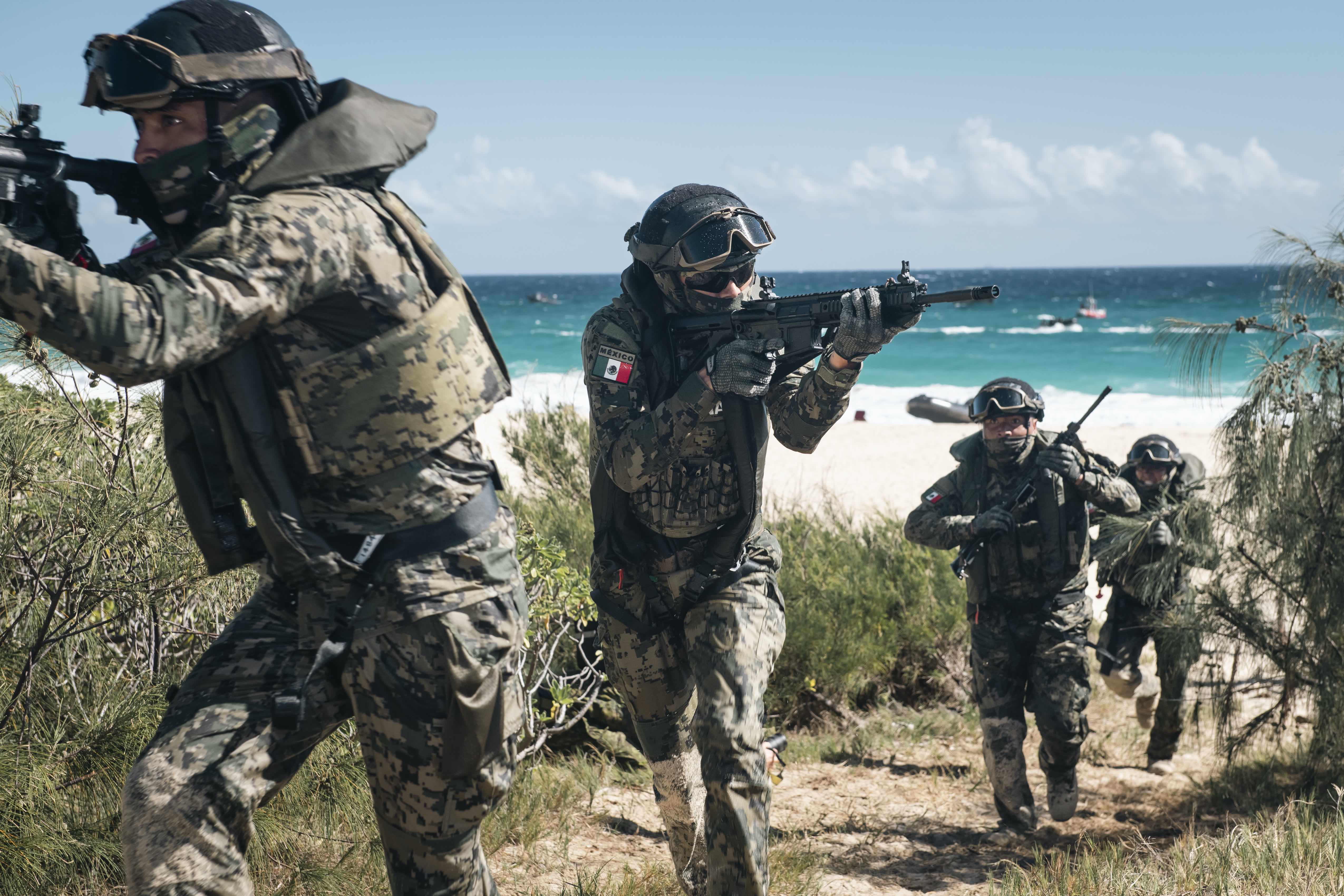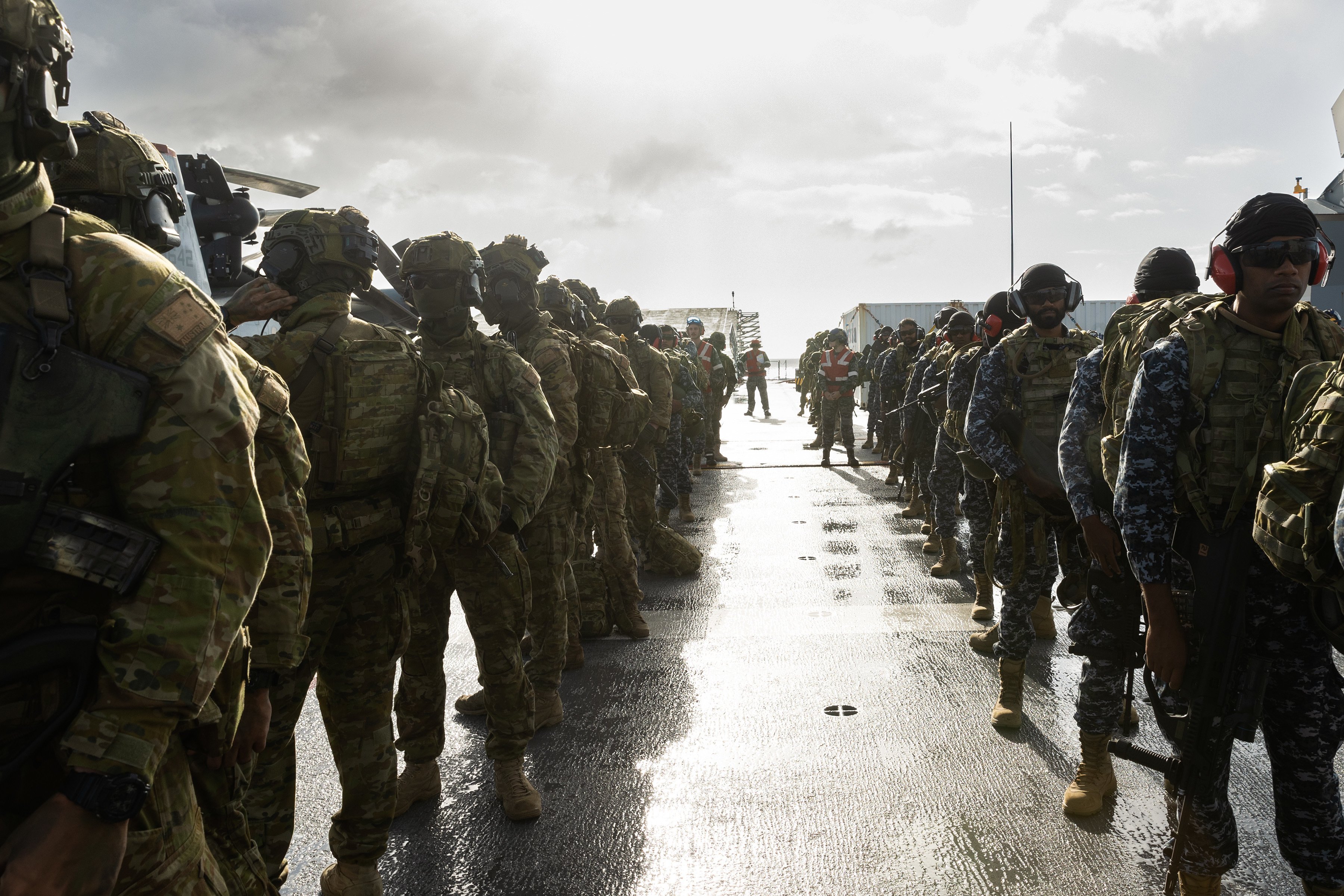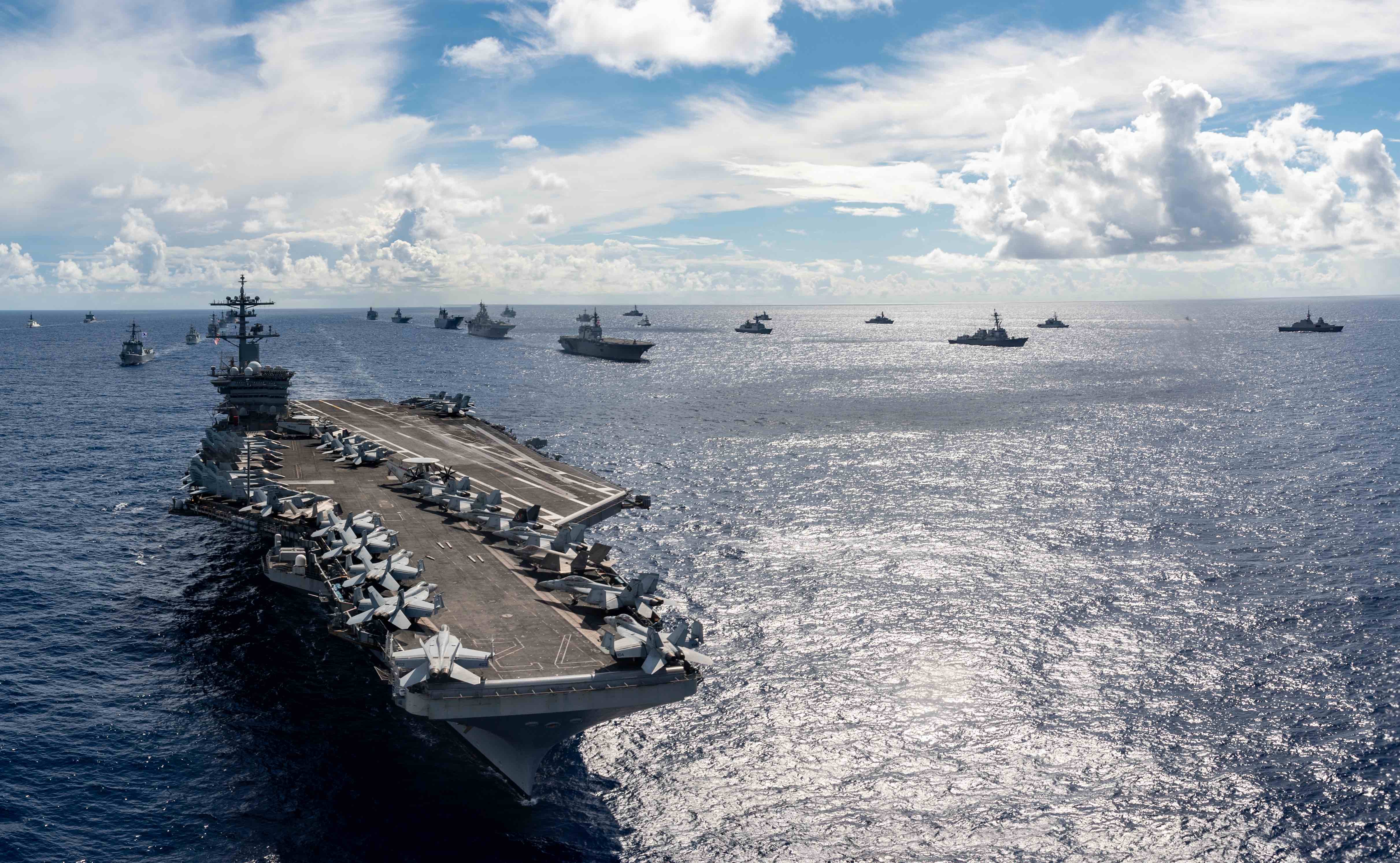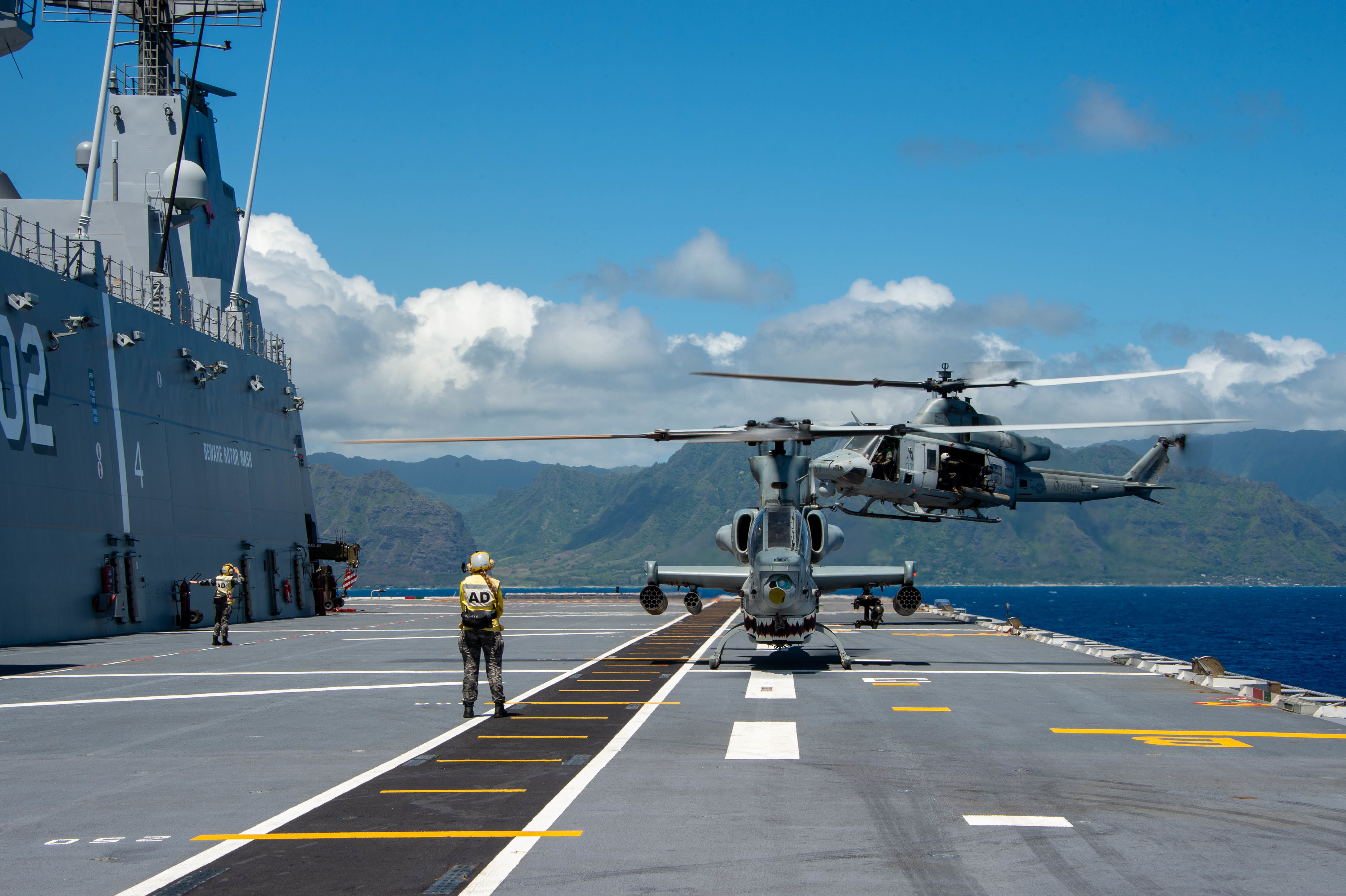
JOINT BASE PEARL HARBOR HICKAM, HAWAII – If deterring China in the Pacific is a team sport, it might resemble a pickup basketball game more than the NBA.
The allied bonds in the Pacific are less rigid than the coalition that makes up NATO in the Atlantic. The complicated web of relationships across the region requires looser coalitions – like the Quad relationship between the U.S., Japan, Australia and India – instead of the structure the U.S. enjoys with its European allies in NATO.
At this year’s Rim of the Pacific 2022 naval exercise, U.S. Navy and partner nation officials described the drills as an effort to make operations between participating countries easier, with a focus on communication.
“We’re going to have to someday plugin as one unit, and whether that’s in a humanitarian assistance or disaster response or if it’s in a high-end fight, we need to be able to come together because no one of us is strong enough to tackle any of those problems, whether it’s HADR or a high-end fight,” Vice Adm. Michael Boyle, the commander of U.S. 3rd Fleet, told USNI News in a recent interview.
In addition to learning how each other’s systems and platforms work, nations attending RIMPAC had the chance for their staffs to work with those from other countries.
“Knowing how people work together, how they react, speeds up that interoperability and that capability and where it matters the most is the unexpected,” Royal Canadian Navy Rear Adm. Christopher Robinson, the deputy commander of RIMPAC, told USNI News.
“[If] an earthquake happens and you assemble a task group and every country comes together and they send their ready use forces, knowing that we’re going to establish initial [communications] on these radios and we’re going to use no call signs or call signs, and we’re going to get together twice a day at certain times and talk, once you’ve established all those really basic common understandings, then you can get to actually achieving the mission.”
Interchangeability

Boyle, who took the helm of 3rd Fleet in June and was the commander of RIMPAC 2022, described a need to push forward past interoperability to achieve interchangeability with allies and partners.
“I tell people that for interchangeability, [it’s] kind of the nexus, the intersection of national objective overlap and interoperability, which is the ability to talk to each other and to work together and to communicate and have tactics that are comparable and complementary,” he said.
When it comes to policy, the United States probably won’t align with a given partner or allied nation on all policy areas, Boyle said. He pointed to a Taiwan Strait transit as an example – performing one may not be in another country’s best interest, but conducting joint operations in the South China Sea could be a better option.
“My argument for interchangeability is that if we try to drive interoperability from the bottom up, from the tactical level up, what always seems to happen in my view … is we run into policy barriers,” he said.
“What seems to work better from my perspective is if we first figure out where our national objectives overlap, then we drive into that space and we have the weight and the leverage of our national command authority,” Boyle added.
“So if it’s important to the nation, then it’s easier to break down the barriers when you can say, ‘hey I really need to get foreign disclosures … for country X because it’s going to enable me to do this thing, which is our national objective. It’s also there’s.’ So it’s win win win. We get interoperability. They take care of their thing. We take care of our thing. And then we drive to the next country or group of countries. You know – multilateral is always better for us – and see where we can find overlapping objectives.”
Working Together

RIMPAC 2022 allowed the U.S. and participating nations the chance to rehearse specific scenarios, like an amphibious landing and humanitarian aid and disaster relief efforts, and hone the communications needed to perform those types of operations.
During a USNI News trip aboard Royal Australian Navy amphibious ship HMAS Canberra (L02), two U.S. Marine Corps MV-22B Ospreys from the “Lucky Red Lions” of Marine Medium Tiltrotor Squadron 363 were parked on the flight deck. Those aircraft remained embarked with Canberra for all of RIMPAC’s at-sea period.
Capt. Jace Hutchison, the commanding officer of Canberra, said this year’s iteration of RIMPAC allowed the RAN to improve upon the lessons learned in 2016, when it began working toward interoperability with the U.S.
“We have developed a lot since 2016. What happened in 2016 was some initial interoperability testing between, in particular U.S. aircraft and Australian amphibious platform[s]. What we’ve been able to do in RIMPAC 2022 is actually take that to the next level,” Hutchison said.
“It’s an opportunity for us to now develop, in an enduring manner, while having two U.S. Marine Corps MV-22 aircraft embarked for the entire sea phase. That’s something that’s not happened before in an Australian context. And we’re really looking forward to expanding the way that we operate those aircraft within the constraints of our platform.”
In addition to having the U.S. Marine Corps Ospreys, Canberra also cross-decked with U.S. aircraft like the Marine Corps CH-53 Sea Stallion and Japanese aircraft, and had the authorities necessary to cross deck with any nation taking part in RIMPAC that brought aircraft to the exercise, Jace said.
Learning how to communicate with each other during those operations was a top priority for the RAN during RIMPAC, said Lt. Samuel Laidlaw, a flight control officer aboard Canberra.
“I think whenever we do international operations, the most challenging thing tends to be communications. So it can be really little things, like it can be some small differences in the way that we refer to the same thing. So understanding those differences,” Laidlaw told reporters in Canberra‘s flight control office.
“We do briefs beforehand. Before any aircraft come across here, we will endeavor to sit down to do a face-to-face brief with them. If we can’t do that. We have a PowerPoint presentation that we put together where we try and spell out all those little differences.”
For example, the U.S. Marine Corps uses magnetic north in operations, while the RAN uses true north. This meant that when the CH-53s flew out to Canberra, the location for where the ship was pointed was 10 degrees off.
“We were giving them to that in true, and they were expecting it in magnetics. There was a bit of a mismatch there,” Laidlaw said.
In addition to communications, obtaining a clear operational picture is key to conducting any missions with allies and partners.
“How do we ensure that this ship from ‘X’ country and this ship from ‘Y’ country are looking at the same picture, that way decisions can be made,” Capt. Dan Brown, the experimentation lead with U.S. 3rd Fleet, told USNI News.
“At the end of the day your commanders always want to be able to sense the battlespace that they’re assigned to and then ultimately [that] allows them to make decisions on what they want to do. And if we’re not all working off the same sheet of music, it’s going to be tough. So that experiment is pretty high visibility at this RIMPAC.”
Part of ensuring ships from different countries can communicate is testing out the Link 22 tactical data link system, which several participating nations – including the U.S., France, Chile and Canada – use.
“Tactical data links sound like they work together seamlessly. But it’s kind of like when you take your … iPhone, and you wander and you grab free WiFi from place to place to place and you still have to login, and sometimes you got to go to a homepage,” Robinson, the Canadian admiral, told USNI News. “Link systems are the same. They should connect seamlessly, but if you haven’t worked with those particular ships, it’s something to work through – making sure you’re all on the same crypto, that you’re changing at the same time, that control frequencies” are the same.
Future Operations

For the Australians, RIMPAC is helping them understand what they can do with U.S. aircraft aboard Canberra, including whether they could deploy U.S. aircraft aboard an Australian ship in the future, akin to the U.S. Marine Corps F-35B Lightning II Joint Strike Fighters that deployed last year aboard United Kingdom aircraft carrier HMS Queen Elizabeth (R08).
Jace, the CO of Canberra, said U.S. Marine Rotational Force – Darwin aircraft could embark aboard Australian ships when they’re forward deployed.
“[Humanitarian Aid and Disaster Relief] is something that Australia does regularly and if we’ve got MRF-D In Australia operating then that’s a perfect partnership to take out into those regional areas and support as a collective,” he said.
Canada’s Robinson acknowledged that more multi-national carrier strike group deployments like the Queen Elizabeth CSG in 2021 – which included RCN frigate HCMS Winnipeg (FFH 338) – could happen. But Robinson said he believed ad hoc naval coalitions are more likely the way maritime nations will operate together.
“I kind of think that shorter groupings – so bringing task groups together for shorter groupings of time and then ships come and go as their national taskings changed – is going to be the way of the future,” Robinson told USNI News.
Boyle said working with allies and partners in the Indo-Pacific – like the United Nations-led Enforcement Coordination Cell for sanctions on North Korea – in particular, is key to deterring China.
“Continuing to make it apparent that they can’t win is the long-term objective and that way we’ll never have to go to war,” Boyle said.
“And man, if we can do it with partners, when they look out and see the ECC … and see Germany, Canada, France, the U.S., Korea all working together right off their coast, then it’s got to be like, ‘our only friend right now is Russia.’ And it’s not really a very good friend, from a China perspective.”





